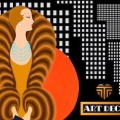From 5 March 2024 to 1 February 2025, the Romans Suta and Aleksandra Beļcova Museum in Riga (Elizabetes iela 57a, Apt. 26) presents the exhibition Body Poetry. Isadora Duncan, Raymond Duncan and the Plastic Dance Tradition in Latvia During the 1920s and 1930s.
The American dancer and choreographer Angela Isadora Duncan (1877–1927) is the most prominent pioneer of modern dance. Her brother, the dancer and artist Raymond Duncan (1874–1966), for whom plastic dance became part of his philosophy of life, supported her. Both were inspired by the art and culture of Ancient Greece, which was reflected in their dance performances and in the costumes – chitons and togas – they wore – Isadora on stage and Raymond daily.
Isadora Duncan abandoned traditional dance forms in search of a new content and foundation for the art of dance. In contrast to classical ballet dancers, the performers of this new dance style appeared barefoot and moved freely, often creating improvisations. Isadora drew inspiration from reflections of nature: the swaying of trees, the rhythmic flow of waves, the gliding of clouds and the flight of a bird. Describing an evening of plastic dance in Riga, a Latvian journalist once called it “body poetry”.
In the first decades of the 20th century, the concept of “modern dance” was not yet widely known. The terms “plastic dance”, “free dance”, “new dance” were more common. In 1913, Isadora Duncan founded a school of plastic dance in Paris, which contributed to the spread of the term.
Raymond Duncan also had his own academy in Paris, but his emphasis was not only on dancing, but also on teaching art, craft and philosophy. Raymond drew, painted silk and made furniture too. His closeness to nature expressed in both – dance and lifestyle: he wore self-woven clothes and self-made shoes like antique sandals, often-surprising contemporaries with his appearance. The objects made by the students of the “Academia Raymond Duncan” were on sale at the Paris gallery “Artiste et artisan” (Artist and Craftsman).
Dance has no restrictions by language and culture, so Isadora Duncan soon had a large audience. In the 1920s, new dance schools and studios were founded in Latvia, popularising plastic, rhythmic plastic dance and the rhythmic method of Émile Jaques-Dalcroze (1865–1950). For example, Anna Ašmane (1888–1967) School of Music and Rhythmic, Beatrise Vīgnere (1903–1990) School of Physical and Aesthetic Education, Anna Kerē (1904–1989) School of Plastic Dance, Mary Wigman (1886–1973) School branch and others. For a brief period in her early childhood, Tatjana Suta (1923–2004), daughter of artists Roman Suta (1896–1944) and Aleksandra Beļcova (1892–1981), attended Beatrise Vīgnere dance studio.
One of the first Latvians who followed the lure of plastic dance was Raymond’s second wife Aija Bertrāne-Dunkane (born Meta Ivanova, 1891–1978). After emigration, she stayed connected with her compatriots: she corresponded with the writer, art theorist Viktors Eglītis (1877–1945), the poet, writer, publicist, politician Jānis Akuraters (1876–1937) and others, as well as tried to translate works of Latvian fiction into French. Many travellers from Latvia came to Paris in the 1920s and 1930s to visit the Duncan family, and some stayed with them at the Academy. Aleksandra Beļcova and her daughter Taņa also met Raymond and Aija.
Duncan’s ideas fascinated Japanese artist Tsuguharu Foujita (1886–1968), who came to Paris shortly before the First World War. The photographs and archive chronicle show Raymond and Cuguharu dancing in antique togas. Fujita’s creative activity was very important to Aleksandra Beļcova, and the painter may have seen his artworks in the Duncan’s home.
The exhibition includes works by Aleksandra Beļcova from the collection of the R. Suta and A. Beļcova Museum, photographs from the collection of the Literature and Music Museum, drawings by Raymond Duncan from the Lithuanian Theatre, Music and Cinema Museum in Vilnius, and a self-portrait by Tsuguharu Foujita from a private collection in Latvia.








